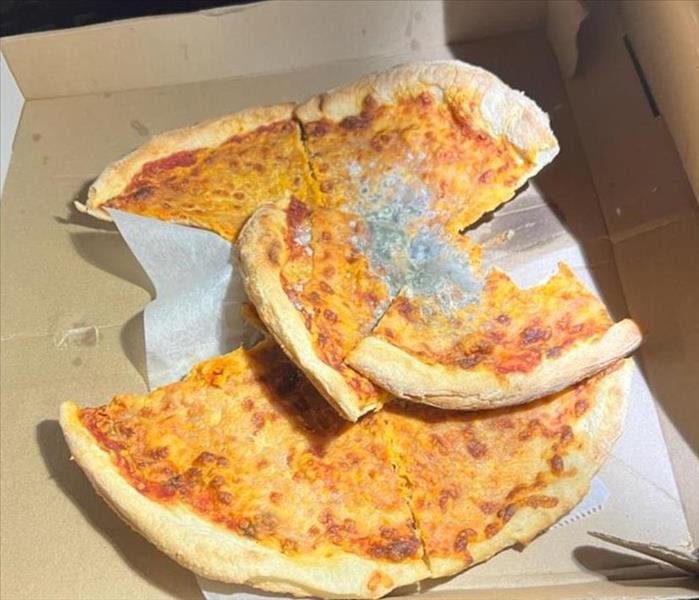Do You Know How Molds Are Used In Our Daily Lives?
1/21/2022 (Permalink)
 Not all molds should be growing on all cheese including this mold growing on old pizza from a hoarding situation in Manchester, NJ.
Not all molds should be growing on all cheese including this mold growing on old pizza from a hoarding situation in Manchester, NJ.
Mold is a scary word to some people but it is very common in our daily lives. Mold is a type of fungus that forms multicellular, thread-like structures. Mold is found everywhere in nature. Some molds are known to cause damage, decay and mild annoyances while others have become indispensable to humans.
Do you know what things are made from mold that most of us have used before?
- The Penicillium mold is one of the first and still one of the most widely used antibiotic agents to make Penicillin, Amoxicillin, Ampicillin and Nafcillin. The PBS News Story has an interesting article, The Real Story of Penicillin, about how Penicillin was first discovered to treat infections. It is truly remarkable how a few doctors changed the course of medicine that we still use in our lives today.
- The second thing made with mold that most of us use are certain kinds of cheeses. Yes, cheese. Blue veined cheese such as Roquefort, blue, Gorgonzola, and Stilton are created by the introduction of Penicillium roqueforti or Penicillium roqueforti spores. Cheeses such as Brie and Camembert have white surface molds. Production involves adding a white mold culture to the curd, causing a white bloom to grow on the surface. The cheese then ripens in four to nine weeks. The longer it is stored, the softer it becomes. Other cheeses have both an internal and a surface mold. The molds used to manufacture these cheeses are safe to eat. Visit Castello to look at some of their white mold cheese.
- Some molds are used in the production of alcohol. Rhizopus has several industrial applications in the manufacturing of enzymes and metabolites such as ethanol, lactic, and fumaric acids. This means that Rhizopus can metabolize starch into glucose, directly fermenting the glucose to give alcohol.
- Koji molds are used to ferment soybeans to make soy sauce. They are also used to make vinegar, as well as fermented beverages, like sake.
Mold can grow on almost all foods. Do you know what common foods are likely to grow mold?
- Fruits: Including strawberries, oranges, grapes, apples and raspberries
- Vegetables: Including tomatoes, bell peppers, cauliflower and carrots
- Bread: Especially when it contains no preservatives
- Cheese: Both soft and hard varieties
- Meats
- Nuts
- Milk
- Processed Foods
Even if mold is only visible on the surface, its roots may lie deep in the food.
What does mold need to grow on these foods?
Most molds need organic matter and oxygen to live, which is why they usually don’t thrive where oxygen is limited. Also, most molds need moisture to live.
Even though some molds are added to particular foods during production to achieve certain effects, the same molds can still spoil other products. Remember that just because some molds are used to make some cheese does not mean you should eat them.
So, how can you prevent mold from growing on your food?
According to healthline, here are their tips to help prevent mold growth in your food:
- Clean your fridge regularly: Wipe out the inside every few months.
- Keep cleaning supplies clean: This includes dishcloths, sponges and other cleaning utensils.
- Don’t let your produce rot: Fresh food has a limited shelf life. Buy a small amount at a time and use it within a few days.
- Keep perishable foods cool: Store foods with limited shelf lives, such as vegetables, in the refrigerator, and don’t leave them out for more than two hours.
- Storage containers should be clean and sealed: Use clean containers when storing food and cover it to prevent exposure to mold spores in the air.
- Use leftover food fast: Eat leftovers within three to four days.
- Freeze for longer-term storage: If you don’t plan on eating the food soon, put it in the freezer.
If you do find mold growing in places that should not have mold, call SERVPRO of Toms River.




 24/7 Emergency Service
24/7 Emergency Service